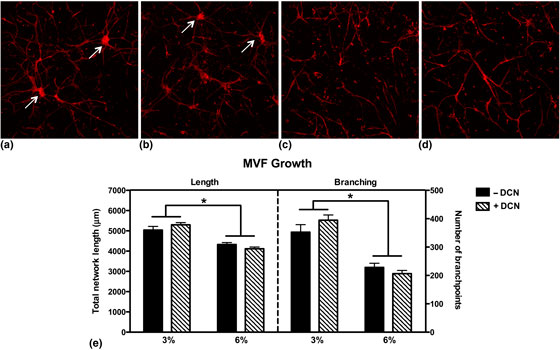Crossref Citations
This article has been cited by the following publications. This list is generated based on data provided by
Crossref.
Gottardi, Riccardo
and
Stoddart, Martin J.
2018.
Regenerative Rehabilitation of the Musculoskeletal System.
Journal of the American Academy of Orthopaedic Surgeons,
Vol. 26,
Issue. 15,
p.
e321.
Ruehle, Marissa A.
Krishnan, Laxminarayanan
Vantucci, Casey E.
Wang, Yuyan
Stevens, Hazel Y.
Roy, Krishnendu
Guldberg, Robert E.
and
Willett, Nick J.
2019.
Effects of BMP‐2 dose and delivery of microvascular fragments on healing of bone defects with concomitant volumetric muscle loss.
Journal of Orthopaedic Research,
Vol. 37,
Issue. 3,
p.
553.
Ruehle, Marissa A.
Li, Mon-Tzu Alice
Cheng, Albert
Krishnan, Laxminarayanan
Willett, Nick J.
and
Guldberg, Robert E.
2019.
Decorin-supplemented collagen hydrogels for the co-delivery of bone morphogenetic protein-2 and microvascular fragments to a composite bone-muscle injury model with impaired vascularization.
Acta Biomaterialia,
Vol. 93,
Issue. ,
p.
210.
Krishnan, Laxminarayanan
LaBelle, Steven A.
Ruehle, Marissa A.
Weiss, Jeffrey A.
Hoying, James B.
and
Guldberg, Robert E.
2019.
Vascularization for Tissue Engineering and Regenerative Medicine.
p.
1.
Ruehle, M. A.
Eastburn, E. A.
LaBelle, S. A.
Krishnan, L.
Weiss, J. A.
Boerckel, J. D.
Wood, L. B.
Guldberg, R. E.
and
Willett, N. J.
2020.
Extracellular matrix compression temporally regulates microvascular angiogenesis.
Science Advances,
Vol. 6,
Issue. 34,
Kalai Selvan, N.
Shanmugarajan, T.S.
and
Uppuluri, Varuna Naga Venkata Arjun
2020.
Hydrogel based scaffolding polymeric biomaterials: Approaches towards skin tissue regeneration.
Journal of Drug Delivery Science and Technology,
Vol. 55,
Issue. ,
p.
101456.
Rebelo, Ana Lúcia
Chevalier, Merari Tumin
Russo, Laura
and
Pandit, Abhay
2021.
Sweet tailoring of glyco-modulatory extracellular matrix-inspired biomaterials to target neuroinflammation.
Cell Reports Physical Science,
Vol. 2,
Issue. 2,
p.
100321.
Golota, Alexander S.
Makarenko, Stanislav V.
Sсherbak, Sergey G.
and
Kamilova, Tatyana A.
2021.
Regenerative Rehabilitation for Bone Tissue Damage.
Physical and rehabilitation medicine, medical rehabilitation,
Vol. 3,
Issue. 1,
p.
48.
Krishnan, Laxminarayanan
LaBelle, Steven A.
Ruehle, Marissa A.
Weiss, Jeffrey A.
Hoying, James B.
and
Guldberg, Robert E.
2021.
Vascularization for Tissue Engineering and Regenerative Medicine.
p.
33.
Sylakowski, Kyle
Hwang, Mintai Peter
Justin, Amritha
Whaley, Diana
Wang, Yadong
and
Wells, Alan
2022.
The matricellular protein decorin delivered intradermally with coacervate improves wound resolution in the CXCR3‐deficient mouse model of hypertrophic scarring.
Wound Repair and Regeneration,
Vol. 30,
Issue. 4,
p.
436.
Vijayan, Ane Nishitha
Solaimuthu, Anbuthiruselvan
Murali, Padmaja
Gopi, Janani
Y, Madhan Teja
R, Akshaya Priya
and
Korrapati, Purna Sai
2022.
Decorin mediated biomimetic PCL-gelatin nano-framework to impede scarring.
International Journal of Biological Macromolecules,
Vol. 219,
Issue. ,
p.
907.
López-Gutierrez, Jorge
Ramos-Payán, Rosalío
Ayala-Ham, Alfredo
Romero-Quintana, José Geovanni
Castillo-Ureta, Hipolito
Villegas-Mercado, Carlos
Bermúdez, Mercedes
Sanchez-Schmitz, Guzman
and
Aguilar-Medina, Maribel
2023.
Biofunctionalization of hydrogel-based scaffolds for vascular tissue regeneration.
Frontiers in Materials,
Vol. 10,
Issue. ,
Le Pennec, Jean
Picart, Catherine
Vivès, Romain R.
and
Migliorini, Elisa
2024.
Sweet but Challenging: Tackling the Complexity of GAGs with Engineered Tailor‐Made Biomaterials.
Advanced Materials,
Vol. 36,
Issue. 11,
Zhang, Zirui
Yao, Pengfei
and
Fan, Shuai
2024.
Advances in regenerative rehabilitation in the rehabilitation of musculoskeletal injuries.
Regenerative Medicine,
Vol. 19,
Issue. 6,
p.
345.



